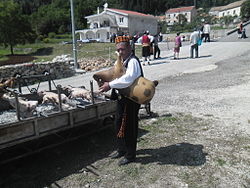| This article needs additional citations for verification. Please help improve this article by adding citations to reliable sources. Unsourced material may be challenged and removed. Find sources: "Diple" – news · newspapers · books · scholar · JSTOR (June 2024) (Learn how and when to remove this message) |
 | |
| Classification | |
|---|---|
| Related instruments | |
| |
Diple (pluralia tantum; pronounced [dîple̞], from Greek δῐπλόος lit. 'double, two-fold'), also known as misnjiče, miješnice and mih, is a traditional woodwind musical instrument originating in the Adriatic Littoral. It is played in Bosnia and Herzegovina, Croatia, Slovenia, Montenegro, and Serbia.
The flute
The diple may be found as a fipple flute or as a reedpipe, but in either case is distinctive in that it incorporates two bores within one body, and thus creates two notes simultaneously. Generally, the left hand fingers a group of holes on the left side of the body, and the right on its side.
Droneless bagpipes
All bagpipe diple have a double chanter with two separate single reeds, which originated in the coastal areas of Dalmatia, Bosnia and Herzegovina, and Montenegro with various difference. The bag of the bagpipes is called a mêh/mijeh/mješina, which consists of a tanned goat skin, the blowpipe is a dulac or gajdenica, through which the air is blown, which is in fact a double chanter used to play the melody and harmony simultaneously. The chanter incorporates two single reeds, one in each bore. The mijeh or diple is played from Istria in the north, down through Lika, Dalmatia, Bosnia and Herzegovina, and ending in Montenegro.
Unlike the majority of European bagpipes, the meh has no drone (trubanj, prdalo, prdaljka), instead playing both a melody and harmony part on the chanter. Though their general form is similar, the meh in different parts of Bosnia varies in chanter tunings, ornamentation, and other small factors. The meh is an untempered instrument, and its specific intonation varies by region.
References
- "dȉple". Hrvatski jezični portal (in Croatian). Retrieved 25 June 2024.
- ^ Baines, Anthony (1979). Bagpipes. United Kingdom: Pitt Rivers Museum. p. 71.
- Talam, Jasmina (2014-07-18). Folk Musical Instruments in Bosnia and Herzegovina. Cambridge Scholars Publishing. ISBN 978-1-4438-6427-5.
- ^ Porter, James; Goertzen, Chris (2017). The Garland Encyclopedia of World Music Europe (8 ed.). United Kingdom: Taylor & Francis. pp. 915, 928, 959–960, 966. ISBN 9781351544269.
- Marković, Zagorka (1987). Narodni muzički instrumenti (in Serbian). Etnografski muzej. p. 75.
- "Puhačka glazbala – Hrvatska tradicijska glazbala" (in Croatian). Retrieved 2023-04-16.
- Marković, Zagorka (21 April 1987). "Narodni muzički instrumenti". Etnografski muzej. p. 75. Retrieved 21 April 2021 – via Google Books.
- Marijana Dlačić; Hrvoje Badurina (2012). "Tajna melodija ovčje kože" (PDF). Muzejovcarstva.org. pp. 17–18.
External links
This article relating to woodwind instruments is a stub. You can help Misplaced Pages by expanding it. |